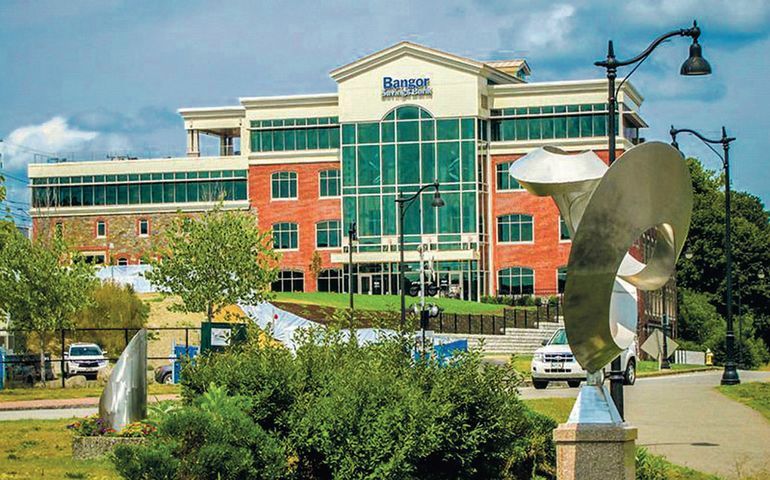Processing Your Payment
Please do not leave this page until complete. This can take a few moments.
- News
-
Editions
View Digital Editions
Biweekly Issues
- December 15, 2025
- December 1, 2025
- Nov. 17, 2025
- November 03, 2025
- October 20, 2025
- October 6, 2025
- + More
Special Editions
- Lists
- Viewpoints
-
Our Events
Event Info
Award Honorees
- Calendar
- Biz Marketplace
Hot property: After decades of decline, cities return to their downtown centers
 Rendering / Courtesy of Covetrus
New headquarters for WEX Inc., along with new headquarters of Tilson and Covetrus (pictured), have revitalized Portland while also stretching its downtown toward the East End and the Old Port.
Rendering / Courtesy of Covetrus
New headquarters for WEX Inc., along with new headquarters of Tilson and Covetrus (pictured), have revitalized Portland while also stretching its downtown toward the East End and the Old Port.
 Photo / Maureen Milliken
In downtown Augusta, where businesses and apartments have been added at an unprecedented rate in the past four years, the effort is driven by an aggressive Downtown Alliance and incentives like the city’s Tipping Point program.
Photo / Maureen Milliken
In downtown Augusta, where businesses and apartments have been added at an unprecedented rate in the past four years, the effort is driven by an aggressive Downtown Alliance and incentives like the city’s Tipping Point program.
 Photo / Peter Van Allen
In Bangor, Bangor Savings Bank, the state’s largest bank, has shown its commitment to the city by building a new headquarters along the waterfront.
Photo / Peter Van Allen
In Bangor, Bangor Savings Bank, the state’s largest bank, has shown its commitment to the city by building a new headquarters along the waterfront.
By the mid-1990s, Maine’s downtowns universally had a similar tired, empty-storefront feel.
Decades of new shopping districts on the outskirts of town, the vestiges of urban renewal and the loss of much of the state’s industrial base, which had been linked to downtown in many communities, had taken their toll.
By 2004, the State Planning Office had targeted revitalizing the state’s “vacant and forlorn” downtowns as a key to the state’s economy, but it warned in a report, “It took decades for our downtowns to deteriorate, and there are no overnight successes.”
Those efforts have become the seeds of new partnerships and efforts that are bringing life to downtowns across the state. The focus has grown in recent years, as both millennials and boomers want to live in or near urban cores that are walkable and full of things to do.
“All my professional life in planning, dating back to the ‘70s, was about slowing the exodus from urban areas,” says Frank O’Hara, a planning consultant. “The ‘cost of sprawl’ was the catch-phrase for my generation.”
O’Hara says that’s what Maine’s Growth Management Act was all about. Enacted in 1988, the plan called for every municipality to have a comprehensive plan by 1996 that designated growth areas for commercial, industrial and residential development and required land use ordinances. Around the same time, in 1999, the Main Street Maine program of the Maine Development Foundation formed. The program helps communities forge private-public partnerships that aim to redevelop downtowns.
With 10 member cities, the program by 2015 had spurred $284.4 million reinvestment in the 10 member communities, with a net gain of 1,184 full-time jobs, 937 building rehabilitations and improvements and a reinvestment ratio of $23.08 for every $1 spent.
A downtown affiliate program was added two years ago, which now has 17 members. Both programs follow the approach of the National Main Street Center, which includes public/private partnerships with local government, downtown businesses and residents.
“This approach has a reputation as one of the most powerful economic development tools in the nation for vibrant, healthy downtowns resulting in job creation, business growth, building rehabilitation and cultural enhancement,” Main Street Maine says on its website.
Municipalities are also finding other ways to bring new life to downtowns spurred by federal tax incentives, local programs and, increasingly, public-private partnerships.
Portland’s downtown has rebounded in recent years, and now faces a shortage of Class-A office space. New development — including headquarters buildings for Tilson, WEX Inc. and Covetrus — has stretched the downtown toward the East End and the Old Port.
In Bangor, Bangor Savings Bank, the state’s largest bank, has shown its commitment to the city by building a new headquarters along the waterfront.
Lewiston has spurred a revitalization of its key Lisbon Street corridor downtown by working with developers and small businesses.
In downtown Augusta, where businesses and apartments have been added at an unprecedented rate in the past four years, the effort is driven by an aggressive Downtown Alliance and incentives like the city’s Tipping Point program, which in partnership with Kennebec Savings Bank offers incentives for small businesses to renovate space and locate downtown.
In downtown Waterville, a $100 million investment by Colby College since 2015 has been a catalyst for other developers.
O’Hara says there is more work to be done, though.
“Now market flows have reversed, and planning must address affordable housing, congestion, lack of public transit,” he said. “And we’re too slow to react.”
Mainebiz web partners

The Giving Guide
The Giving Guide helps nonprofits have the opportunity to showcase and differentiate their organizations so that businesses better understand how they can contribute to a nonprofit’s mission and work.
Learn More
Work for ME
Work for ME is a workforce development tool to help Maine’s employers target Maine’s emerging workforce. Work for ME highlights each industry, its impact on Maine’s economy, the jobs available to entry-level workers, the training and education needed to get a career started.
Learn More
Groundbreaking Maine
Whether you’re a developer, financer, architect, or industry enthusiast, Groundbreaking Maine is crafted to be your go-to source for valuable insights in Maine’s real estate and construction community.
Learn more-
The Giving Guide
The Giving Guide helps nonprofits have the opportunity to showcase and differentiate their organizations so that businesses better understand how they can contribute to a nonprofit’s mission and work.
-
Work for ME
Work for ME is a workforce development tool to help Maine’s employers target Maine’s emerging workforce. Work for ME highlights each industry, its impact on Maine’s economy, the jobs available to entry-level workers, the training and education needed to get a career started.
-
Groundbreaking Maine
Whether you’re a developer, financer, architect, or industry enthusiast, Groundbreaking Maine is crafted to be your go-to source for valuable insights in Maine’s real estate and construction community.
ABOUT
NEW ENGLAND BUSINESS MEDIA SITES
No articles left
Get access now
In order to use this feature, we need some information from you. You can also login or register for a free account.
By clicking submit you are agreeing to our cookie usage and Privacy Policy
Already have an account? Login
Already have an account? Login
Want to create an account? Register
Get access now
In order to use this feature, we need some information from you. You can also login or register for a free account.
By clicking submit you are agreeing to our cookie usage and Privacy Policy
Already have an account? Login
Already have an account? Login
Want to create an account? Register







0 Comments